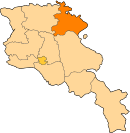Gosh, Armenia: Difference between revisions
JJMC89 bot (talk | contribs) Migrate {{Infobox settlement}} coordinates parameters to {{Coord}}, see Wikipedia:Coordinates in infoboxes |
Rescuing 1 sources and tagging 0 as dead. #IABot (v1.3beta3) |
||
| Line 44: | Line 44: | ||
== References == |
== References == |
||
*{{GEOnet2|32FA881E6FD33774E0440003BA962ED3}} |
*{{GEOnet2|32FA881E6FD33774E0440003BA962ED3}} |
||
*[http://world-gazetteer.com/wg.php?x=&men=gcis&lng=en&des=wg&geo=-17&srt=npan&col=abcdefghinoq&msz=1500&pt=c&va=x World Gazeteer: Armenia] – World-Gazetteer.com |
*[https://web.archive.org/web/20130602113030/http://world-gazetteer.com/wg.php?x=&men=gcis&lng=en&des=wg&geo=-17&srt=npan&col=abcdefghinoq&msz=1500&pt=c&va=x World Gazeteer: Armenia] – World-Gazetteer.com |
||
*{{ArmenianCensus|116}} |
*{{ArmenianCensus|116}} |
||
Revision as of 11:30, 23 March 2017
40°43′21″N 45°00′12″E / 40.72250°N 45.00333°E
Gosh Գոշ | |
|---|---|
 | |
| Coordinates: 40°43′21″N 45°00′12″E / 40.72250°N 45.00333°E | |
| Country | Armenia |
| Marz (Province) | Tavush |
| Population (2008) | |
| • Total | 1,079 |
| Time zone | UTC+4 ( ) |
Gosh (Armenian: Գոշ) is a village located in the Tavush Province of Armenia. It is named after Mkhitar Gosh who took part in the re-building of the older monastery of Nor Ghetik during the 12th-13th centuries, which had been destroyed by an earthquake in 1188. The newly built monastery was later named Goshavank in honor of Mkhitar. Goshavank is located just off the main highway that runs through town. On a hillside west of the monastery complex sits a chapel that also serves as the tomb of Mkhitar Gosh. It was situated to overlook the monastery in which he helped build. The chapel is square in plan with a single centrally located dome above and one portal. Nearby are the ruins of what are said to be Mkhitar's house. Stone foundations and low walls still exist.
Gallery
-
View of the village
-
Goshavank, August 2009.
-
Mkhitar Gosh's funeral chapel.
-
The ruins of Mikhtar Gosh's house.
-
Gosh lake
References
- Gosh, Armenia at GEOnet Names Server
- World Gazeteer: Armenia – World-Gazetteer.com
- Report of the results of the 2001 Armenian Census, Statistical Committee of Armenia







